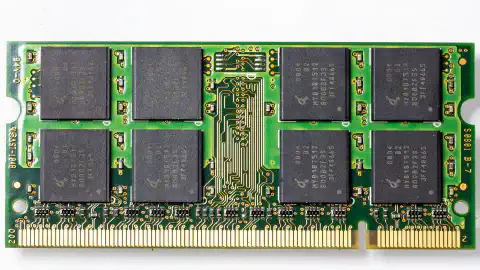RAID Technology Decoded: Enhancing Data Storage with Redundancy

Table of Contents
Understanding RAID: Types and Their Uses in Data Storage
RAID (Redundant Array of Independent Disks) is a technology used in data storage to improve performance, reliability, and fault tolerance. It involves combining multiple physical disk drives into a single logical unit to provide redundancy and increase data access speed. RAID has evolved over the years, with different levels and implementations offering various benefits and trade-offs. In this article, we will explore the different types of RAID and their uses in data storage.
Key Takeaways
- RAID is a technology used in data storage to improve performance, reliability, and fault tolerance.
- There are different levels of RAID, including RAID 0, RAID 1, RAID 5, RAID 10, and RAID 6, each with its own advantages and use cases.
- RAID can be implemented using hardware RAID controllers or software RAID solutions.
- RAID provides benefits such as data backup and recovery, improved performance, fault tolerance, large-scale data storage, and support for video editing and media production.
- Considerations when using RAID include cost vs. performance trade-offs, data security, RAID rebuild time, compatibility and interoperability, and the risk of RAID failure and data loss.
Introduction to RAID
What is RAID?
RAID, which stands for Redundant Array of Independent Disks, is a data storage technology that combines multiple physical drives into a single logical unit. This allows for improved performance, fault tolerance, and increased storage capacity.
RAID uses a technique called data striping, where data is divided into blocks and distributed across multiple drives. By spreading the data across multiple drives, RAID can read and write data in parallel, resulting in faster data access and transfer speeds.
RAID also provides redundancy by using various methods such as mirroring and parity. Mirroring creates an exact copy of data on multiple drives, ensuring data availability even if one drive fails. Parity, on the other hand, calculates and stores additional information that can be used to reconstruct data in case of a drive failure.
Overall, RAID offers a way to improve data storage performance, protect against data loss, and increase storage capacity by combining multiple drives into a single logical unit.
History of RAID
RAID, which stands for Redundant Array of Independent Disks, was first introduced in the late 1980s as a way to improve data storage reliability and performance. It was developed by a team of researchers at the University of California, Berkeley, led by Professor David Patterson. The concept of RAID was born out of the need to address the limitations of traditional single-disk storage systems.
RAID technology has evolved over the years, with different RAID levels offering varying levels of data redundancy, performance, and capacity. Today, RAID is widely used in various industries and applications that require high availability, fault tolerance, and efficient data storage and retrieval.
Here are some key milestones in the history of RAID:
- RAID 0, also known as striping, was the first RAID level introduced. It provided improved performance by spreading data across multiple disks.
- RAID 1, or mirroring, offered data redundancy by creating an exact copy of the data on two or more disks.
- RAID 5 introduced distributed parity, which allowed for data recovery in case of a single disk failure.
- RAID 10 combined the benefits of mirroring and striping, providing both performance and redundancy.
- RAID 6 added dual parity, allowing for recovery from the failure of two disks.
These different RAID levels have their own strengths and are suited for different use cases. Understanding the history of RAID helps us appreciate the advancements in data storage technology and the benefits it brings to modern computing.
Advantages of RAID
RAID offers several advantages that make it a popular choice for data storage:
- Improved Performance: RAID can improve read and write speeds by distributing data across multiple drives, allowing for parallel access.
- Data Redundancy: RAID provides data redundancy by storing multiple copies of data across multiple drives, reducing the risk of data loss in case of drive failure.
- Fault Tolerance: RAID can continue to function even if one or more drives fail, ensuring uninterrupted access to data.
- Scalability: RAID systems can be easily expanded by adding more drives, allowing for increased storage capacity.
- Cost-Effective: RAID offers a cost-effective solution for data storage, as it allows for the use of lower-cost drives without sacrificing performance or reliability.
- Flexibility: RAID systems can be configured in different levels to meet specific performance, capacity, and redundancy requirements.
- Data Accessibility: RAID provides improved data accessibility, as data can be accessed from multiple drives simultaneously, reducing latency and improving overall system performance.
RAID Levels
RAID 0: Striping
RAID 0, also known as striping, is a RAID level that focuses on improving data transfer speeds and performance. It achieves this by dividing data into blocks and distributing them across multiple drives simultaneously.
- The data is striped across the drives, allowing for parallel read and write operations, which significantly enhances the overall throughput.
- RAID 0 does not provide any redundancy or fault tolerance. If one drive fails, the entire array becomes inaccessible, resulting in data loss.
- This RAID level is ideal for applications that require high-speed data access, such as video editing and gaming, where performance is prioritized over data redundancy.
Key Features of RAID 0
| Feature | Description |
|---|---|
| Improved Performance | RAID 0 offers improved read and write speeds due to parallel data access across multiple drives. |
| No Redundancy | RAID 0 does not provide any data redundancy or fault tolerance. |
| Increased Storage Capacity | The total storage capacity of RAID 0 is the sum of the capacities of all the drives in the array. |
Tip: RAID 0 should not be used for critical data storage or applications that require data protection, as a single drive failure can result in complete data loss.
RAID 1: Mirroring
RAID 1, also known as mirroring, is a data storage technique that involves creating an exact copy of data on two or more drives. This redundancy provides increased data reliability and fault tolerance.
- Each drive in a RAID 1 array contains the same data, ensuring that if one drive fails, the data can still be accessed from the remaining drives.
- RAID 1 offers excellent read performance as data can be read from multiple drives simultaneously.
- Write performance, however, is limited to the speed of the slowest drive in the array.
- RAID 1 is commonly used for critical applications where data integrity and availability are of utmost importance, such as database servers and financial systems.
Advantages of RAID 1:
- Enhanced data redundancy and fault tolerance
- Improved read performance
- Quick data recovery in case of drive failure
- Suitable for applications requiring high data integrity and availability
Tip: RAID 1 is an effective solution for protecting important data, but it comes at the cost of using additional storage capacity due to the mirroring process.
RAID 5: Distributed Parity
RAID 5 is a RAID level that uses distributed parity to provide fault tolerance and data protection. It is commonly used in data storage systems where both performance and data redundancy are important.
RAID 5 works by striping data across multiple drives, similar to RAID 0, but also includes parity information. Parity information is calculated and distributed across all the drives in the array, providing redundancy in case of a drive failure.
One important characteristic of RAID 5 is its ability to rebuild data in case of a drive failure. When a drive fails, the missing data can be reconstructed using the parity information and the data from the remaining drives. This process is known as rebuilding and helps to maintain data integrity and availability.
Here are some key points about RAID 5:
- Provides fault tolerance by distributing parity information across multiple drives.
- Offers a good balance between performance and data redundancy.
- Requires a minimum of three drives to implement.
- Can withstand the failure of a single drive without losing data.
- Rebuilding data after a drive failure can take time, especially with larger drives.
In summary, RAID 5 is a popular RAID level that combines striping and distributed parity to provide both performance and fault tolerance. It is commonly used in data storage systems where data redundancy and performance are important.
RAID 10: Combining Mirroring and Striping
RAID 10 combines the benefits of mirroring and striping to provide both performance and fault tolerance. It is also known as RAID 1+0.
In RAID 10, data is first striped across multiple drives, similar to RAID 0, to improve read and write performance. Then, each striped set is mirrored onto another set of drives, providing redundancy and fault tolerance. This means that if one drive fails, the mirrored drive can take over, ensuring data availability.
RAID 10 requires a minimum of four drives, as it needs at least two drives for striping and two drives for mirroring. The total usable capacity of RAID 10 is half of the total capacity of all the drives.
The advantages of RAID 10 include:
- High performance due to striping
- High fault tolerance due to mirroring
- Fast rebuild times in case of drive failure
- Ability to sustain multiple drive failures in different mirrored sets
It is commonly used in applications that require both high performance and data protection, such as databases, virtualization, and critical business applications.
RAID 6: Dual Parity
RAID 6 is a type of RAID level that provides a high level of data protection and fault tolerance. It is similar to RAID 5 in that it uses distributed parity, but it adds an additional parity block to provide dual parity protection.
- RAID 6 is designed to protect against the failure of two drives simultaneously, making it more resilient than RAID 5.
- The dual parity feature allows RAID 6 to rebuild data even if two drives fail, reducing the risk of data loss.
- However, RAID 6 requires a minimum of four drives to implement, as it needs two drives for data storage and two drives for parity.
- RAID 6 offers excellent data protection and is suitable for applications that require high fault tolerance, such as large-scale data storage and critical data backup.
Tip: When considering RAID 6, it’s important to balance the increased data protection with the cost of additional drives and the potential impact on performance.
RAID Use Cases
Data Backup and Recovery
Data backup and recovery is a critical aspect of data storage. It involves creating copies of important data to protect against data loss and ensuring that data can be restored in the event of a failure. Backup refers to the process of creating duplicate copies of data, while recovery involves restoring the data from those copies.
- Data backup and recovery is essential for business continuity and disaster recovery planning.
- Regular backups help protect against accidental deletion, hardware failures, software errors, and cyberattacks.
- There are different backup strategies, including full backups, incremental backups, and differential backups.
- Offsite backups are important to protect against physical damage or loss of data due to natural disasters or theft.
Tip: Test your backup and recovery processes regularly to ensure they are working effectively and that you can restore your data when needed.
Improved Performance
Improved performance is one of the key benefits of using RAID. By distributing data across multiple drives and allowing for parallel access, RAID can significantly enhance read and write speeds. This is particularly beneficial for applications that require high data throughput, such as database servers and video editing workstations.
RAID achieves improved performance through various techniques:
- Striping: RAID 0 utilizes striping to divide data into blocks and distribute them across multiple drives. This allows for simultaneous data access from multiple drives, resulting in faster read and write operations.
- Parallel Processing: RAID levels like RAID 5 and RAID 6 use distributed parity to enable parallel processing of data across multiple drives. This further enhances performance by allowing multiple drives to work together in processing data.
- Caching: Some RAID controllers offer caching capabilities, where frequently accessed data is stored in a cache for faster retrieval.
Overall, RAID’s improved performance makes it an ideal choice for applications that require fast and efficient data access.
Fault Tolerance
Fault tolerance is a critical aspect of RAID, ensuring that data remains accessible even in the event of hardware failures. RAID provides redundancy by distributing data across multiple drives, allowing for the recovery of lost data if one or more drives fail.
- RAID levels such as RAID 1, RAID 5, and RAID 6 offer fault tolerance by using mirroring, distributed parity, and dual parity techniques respectively.
- Mirroring, also known as RAID 1, creates an exact copy of data on two or more drives, providing redundancy and allowing for seamless data recovery in case of a drive failure.
- Distributed parity, used in RAID 5, distributes parity information across all drives in the array, allowing for the reconstruction of data if a single drive fails.
- RAID 6 goes a step further by using dual parity, which allows for the recovery of data even if two drives fail simultaneously.
Table: RAID Levels and Fault Tolerance
| RAID Level | Fault Tolerance |
|---|---|
| RAID 0 | No fault tolerance |
| RAID 1 | High fault tolerance |
| RAID 5 | Moderate fault tolerance |
| RAID 6 | High fault tolerance |
In addition to providing fault tolerance, RAID also offers improved performance and data security, making it a versatile solution for various data storage needs.
Large-Scale Data Storage
Large-scale data storage refers to the use of RAID technology to store and manage vast amounts of data. This is particularly important for organizations that deal with massive data sets, such as cloud service providers, data centers, and scientific research institutions.
Benefits of RAID for Large-Scale Data Storage:
- Improved Performance: RAID allows for parallel data access and distribution across multiple drives, resulting in faster read and write speeds.
- Fault Tolerance: RAID provides redundancy and fault tolerance, ensuring that data remains accessible even if one or more drives fail.
- Scalability: RAID systems can easily accommodate the addition of more drives, allowing for seamless expansion as data storage needs grow.
- Data Striping: RAID striping distributes data across multiple drives, increasing the overall storage capacity and enabling efficient data retrieval.
Tip: When implementing RAID for large-scale data storage, it is important to consider the specific requirements of your organization and choose the appropriate RAID level and configuration.
Example RAID Configuration for Large-Scale Data Storage:
| RAID Level | Description |
|---|---|
| RAID 5 | Distributed parity across multiple drives |
| RAID 6 | Dual parity for increased fault tolerance |
By using RAID 5 or RAID 6, organizations can achieve a balance between performance, fault tolerance, and storage efficiency for large-scale data storage.
Video Editing and Media Production
Video editing and media production are demanding tasks that require high-performance storage solutions. RAID provides the necessary fault tolerance and improved performance for these applications. By using RAID, video editors and media producers can ensure that their data is protected from drive failures and can access and process large video files quickly and efficiently.
RAID also offers the ability to scale storage capacity as needed, allowing for the storage of large video libraries. Additionally, the redundancy provided by RAID ensures that even if a drive fails, the data can still be accessed and edited without interruption.
For video editing and media production, a RAID level that offers a good balance between performance and fault tolerance is RAID 5. RAID 5 distributes parity information across multiple drives, providing both data striping and redundancy. This allows for high read and write speeds while still protecting against drive failures.
In summary, RAID is an essential technology for video editing and media production, providing fault tolerance, improved performance, scalability, and data protection.
RAID Implementation
Hardware RAID
Hardware RAID refers to the implementation of RAID using a dedicated hardware controller. This controller is a separate component that is installed in the computer system and is responsible for managing the RAID array.
Some key points to consider about Hardware RAID:
- Performance: Hardware RAID controllers often have dedicated processors and cache memory, which can significantly improve the performance of the RAID array.
- Reliability: Hardware RAID controllers are designed to handle the complexities of RAID configurations and provide better fault tolerance and data protection.
- Scalability: Hardware RAID controllers support a wide range of RAID levels and can handle large storage capacities, making them suitable for enterprise-level storage solutions.
- Ease of Use: Hardware RAID controllers typically come with their own management software, which makes it easier to configure and monitor the RAID array.
In summary, Hardware RAID offers improved performance, reliability, scalability, and ease of use compared to software-based RAID solutions.
Software RAID
Software RAID is a method of implementing RAID using software rather than dedicated hardware. It allows for the creation of RAID arrays using the existing resources of a computer system.
Software RAID offers several advantages:
- Flexibility: Software RAID can be implemented on any computer system that supports the necessary software. This makes it a cost-effective option for small businesses or individuals who may not have access to specialized RAID hardware.
- Ease of Setup: Setting up a software RAID array is relatively straightforward and can be done using the operating system’s built-in tools or third-party software.
- Compatibility: Software RAID is compatible with a wide range of operating systems, including Windows, macOS, and Linux.
However, there are some considerations to keep in mind when using software RAID:
- Performance: Software RAID may not perform as well as hardware RAID, especially in high-demand environments.
- System Resources: Software RAID relies on the computer’s CPU and memory, which can impact overall system performance.
- Limited Scalability: Software RAID may have limitations in terms of the number of drives or RAID levels that can be supported.
In summary, software RAID provides a flexible and cost-effective solution for implementing RAID on computer systems. While it may not offer the same level of performance as hardware RAID, it is compatible with a wide range of operating systems and can be easily set up using existing resources.
RAID Controllers
RAID controllers play a crucial role in managing and controlling the data storage process in a RAID system. These controllers are responsible for coordinating the data transfer between the computer’s operating system and the RAID array. They provide the necessary hardware and firmware to ensure the efficient operation of the RAID system.
- RAID controllers are available in both hardware and software forms. Hardware RAID controllers are dedicated expansion cards that are installed in the computer system, while software RAID controllers are implemented through the computer’s operating system.
- Hardware RAID controllers typically offer better performance and reliability due to their dedicated hardware resources and advanced features.
- Software RAID controllers, on the other hand, rely on the computer’s CPU and memory, which can impact overall system performance.
When choosing a RAID controller, it is important to consider factors such as the desired RAID level, the number of drives supported, and the required performance and reliability. Additionally, compatibility with the computer’s operating system and the RAID configuration software should also be taken into account.
Tip: It is recommended to use a hardware RAID controller for high-performance applications or critical data storage, while software RAID controllers can be suitable for smaller-scale setups or non-critical data storage.
RAID Configuration
RAID configuration refers to the process of setting up and organizing the RAID array for optimal performance and data protection.
- The configuration involves selecting the appropriate RAID level based on the specific requirements of the system.
- It also includes determining the number and size of the hard drives or SSDs to be used in the array.
- RAID configuration involves setting up the striping or mirroring parameters, such as stripe size or block size.
- It may also involve configuring additional features like hot swapping and hot spare drives.
Table: RAID Configuration Parameters
| Parameter | Description |
|---|---|
| RAID Level | The specific RAID level chosen for the array |
| Drive Configuration | The number and size of drives used in the array |
| Stripe Size | The size of the data blocks used for striping |
| Mirroring | The method and redundancy level for mirroring |
| Hot Swapping | The ability to replace drives without shutting down the system |
Tip: When configuring RAID, it is important to consider the specific needs of the system, such as performance requirements, data storage capacity, and fault tolerance.
Overall, RAID configuration plays a crucial role in determining the performance, reliability, and data protection capabilities of the RAID array.
Hot Swapping and Hot Spare
Hot swapping and hot spare are two important concepts in RAID implementation.
Hot swapping refers to the ability to replace a failed or faulty drive in a RAID array without shutting down the system. This is achieved by using hot-swappable drives that can be inserted or removed while the system is running. Hot swapping helps minimize downtime and allows for easy maintenance and upgrades.
Hot spare, on the other hand, is an extra drive that is kept in the RAID array but remains inactive until a drive failure occurs. When a drive fails, the hot spare automatically takes over, replacing the failed drive and ensuring the continuity of the RAID array. Hot spare drives are typically of the same capacity and type as the other drives in the array.
Implementing hot swapping and hot spare in a RAID configuration provides additional fault tolerance and improves the reliability of the storage system.
Here is a table summarizing the key differences between hot swapping and hot spare:
| Hot Swapping | Hot Spare |
|---|---|
| Allows for drive replacement without system shutdown | Remains inactive until a drive failure occurs |
| Minimizes downtime and allows for easy maintenance and upgrades | Automatically takes over when a drive fails |
| Requires hot-swappable drives | Requires an extra drive in the RAID array |
It is important to note that hot swapping and hot spare are not mutually exclusive and can be used together to further enhance the fault tolerance and availability of a RAID system.
RAID Considerations
Cost vs. Performance
When considering RAID implementations, one important factor to consider is the trade-off between cost and performance. Different RAID levels offer varying levels of performance and cost-effectiveness.
- RAID 0, for example, provides excellent performance by striping data across multiple drives, but it offers no data redundancy and is more susceptible to data loss.
- On the other hand, RAID 1 offers full data redundancy by mirroring data on multiple drives, but it comes at the cost of reduced storage capacity and lower write performance.
- RAID 5 provides a good balance between performance and redundancy by distributing parity across multiple drives, allowing for data recovery in case of a single drive failure.
- RAID 10 combines the benefits of striping and mirroring, offering both high performance and data redundancy, but it requires a larger number of drives.
- RAID 6 offers dual parity, providing even higher fault tolerance, but it requires more drives and has a higher cost.
When choosing a RAID level, it is important to consider the specific needs of the data storage system and find the right balance between cost and performance.
Data Security
Data security is a critical aspect of RAID implementations. With the increasing threat of data breaches and cyber attacks, protecting sensitive information is of utmost importance. RAID provides several features that enhance data security:
Redundancy: RAID levels like RAID 1, RAID 5, and RAID 6 offer redundancy by storing multiple copies of data across different drives. This redundancy ensures that even if one drive fails, the data can still be accessed from the remaining drives.
Data Encryption: Some RAID controllers and software RAID solutions support data encryption, which adds an extra layer of security to the stored data. Encryption algorithms like AES (Advanced Encryption Standard) can be used to encrypt the data at the block level.
Access Control: RAID systems often provide access control mechanisms, allowing administrators to define user permissions and restrict unauthorized access to the stored data.
Monitoring and Auditing: RAID systems can include monitoring and auditing features to track access to the data and detect any suspicious activities.
Backup and Disaster Recovery: RAID can be used in conjunction with backup and disaster recovery strategies to ensure data availability and protection in case of system failures or disasters.
Data security should be a top priority when implementing RAID systems, and organizations should carefully consider the specific security features offered by different RAID levels and configurations.
RAID Rebuild Time
RAID rebuild time refers to the time it takes to rebuild a RAID array after a disk failure. It is an important consideration as it affects the availability of data and the overall performance of the system.
- The rebuild time depends on the size of the disks in the array and the amount of data stored on them. Larger disks and higher data volumes can result in longer rebuild times.
- During the rebuild process, the system is under increased stress, which can impact the performance of other operations.
- RAID controllers with dedicated hardware can often perform rebuilds faster than software-based RAID implementations.
- It is recommended to monitor the rebuild progress and prioritize critical data during the process.
Tip: Regularly backing up data can help mitigate the impact of longer rebuild times and reduce the risk of data loss.
- In some cases, RAID rebuilds can be time-consuming, especially for larger arrays. It is important to consider this factor when planning for system maintenance or upgrades.
- RAID rebuild time can be reduced by using techniques such as hot swapping and hot spare, which allow for the replacement of failed disks without interrupting the system.
- It is advisable to consult the manufacturer’s documentation or seek professional assistance for specific guidance on RAID rebuild time and best practices.
Compatibility and Interoperability
When implementing RAID systems, it is important to consider compatibility and interoperability with existing hardware and software. Compatibility refers to the ability of the RAID system to work seamlessly with other components in the system, such as the operating system, drivers, and applications. Interoperability, on the other hand, refers to the ability of the RAID system to communicate and function properly with different devices and systems.
To ensure compatibility and interoperability, it is recommended to:
- Choose a RAID level that is supported by the operating system and hardware.
- Verify that the RAID controller or software is compatible with the system’s architecture.
- Check for any known compatibility issues or limitations with specific hardware or software components.
- Consider future expansion or upgrades and ensure compatibility with potential new components.
It is also important to keep in mind that compatibility and interoperability can vary depending on the specific RAID implementation and the technology used. Therefore, it is advisable to consult the documentation and support resources provided by the RAID manufacturer or software developer for detailed compatibility information.
RAID Failure and Data Loss
RAID systems are designed to provide fault tolerance and data protection. However, like any technology, RAID is not immune to failures and data loss. It is important to understand the potential risks and take appropriate measures to mitigate them.
Common Causes of RAID Failure and Data Loss
- Hardware failures: Components such as hard drives, RAID controllers, or power supplies can fail, leading to data loss.
- Human errors: Accidental deletion, formatting, or overwriting of data can result in permanent loss.
- Software issues: RAID management software or firmware bugs can cause data corruption or system instability.
- Natural disasters: Fires, floods, or other catastrophic events can damage the physical infrastructure and result in data loss.
Mitigating RAID Failure and Data Loss
To minimize the risk of RAID failure and data loss, consider the following:
- Regular backups: Implement a backup strategy that includes off-site storage to protect against hardware failures and disasters.
- Monitoring and maintenance: Regularly monitor the health of RAID components and perform necessary maintenance tasks, such as firmware updates and disk replacements.
- Redundancy: Choose RAID levels that provide redundancy, such as RAID 1 or RAID 6, to protect against single drive failures.
- RAID rebuild time: Understand the time it takes to rebuild a RAID array after a failure and plan accordingly.
- Data recovery services: In case of severe data loss, consider professional data recovery services that specialize in RAID systems.
Tip: It is crucial to regularly test the integrity of your backups and ensure they can be successfully restored when needed.
By understanding the potential causes of RAID failure and data loss and implementing appropriate measures, you can minimize the risks and ensure the reliability of your RAID storage system.
Conclusion
In conclusion, RAID (Redundant Array of Independent Disks) is a technology that offers various levels of data protection, performance improvement, and storage capacity expansion. It has become an essential component in modern data storage systems, providing benefits such as fault tolerance, improved performance, and data backup and recovery. RAID offers different levels, including RAID 0, RAID 1, RAID 5, RAID 10, and RAID 6, each with its own advantages and use cases. When implementing RAID, there are considerations to keep in mind, such as the cost-performance trade-off, data security, RAID rebuild time, compatibility, and the possibility of RAID failure and data loss. Overall, RAID is a versatile technology that plays a crucial role in meeting the storage needs of various industries, including large-scale data storage, video editing, and media production.
Frequently Asked Questions
What is RAID?
RAID stands for Redundant Array of Independent Disks. It is a data storage technology that combines multiple physical disk drives into a single logical unit for improved performance, fault tolerance, and data protection.
What are the different RAID levels?
The different RAID levels include RAID 0, RAID 1, RAID 5, RAID 10, and RAID 6. Each level has its own characteristics and uses in data storage.
What is RAID 0?
RAID 0, also known as striping, splits data across multiple disks without redundancy. It offers improved performance by allowing data to be read from and written to multiple disks simultaneously.
What is RAID 1?
RAID 1, also known as mirroring, duplicates data across multiple disks for redundancy. It provides fault tolerance by ensuring that data is still accessible even if one disk fails.
What is RAID 5?
RAID 5 uses distributed parity to provide fault tolerance and improved performance. It distributes parity information across all disks in the array, allowing for recovery of data in case of a single disk failure.
What is RAID 10?
RAID 10 combines mirroring and striping to provide both redundancy and improved performance. It requires a minimum of four disks and offers better fault tolerance than RAID 5.





